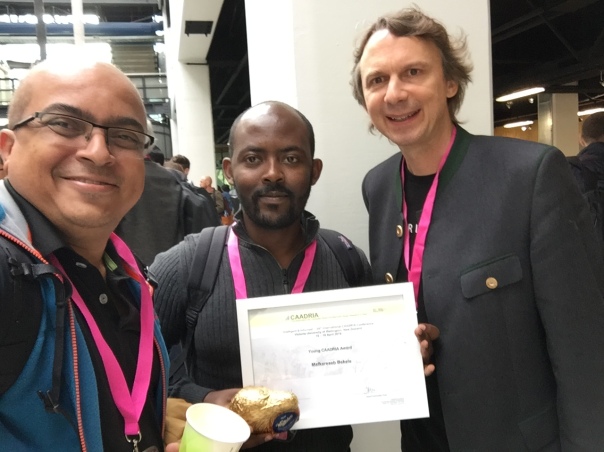
I was the second-author of two papers presented at CAADRIA 2019: INTELLIGENT & INFORMED in Wellington New Zealand, and they are now published in CUMINCAD. The primary authors were Mafkereseb Bekele for the first paper (he won a Young CAADRIA award) and Hafizur Rahaman for the second paper, both are colleagues at Curtin University, Mafkereseb is a PhD student here and Hafizur is a Research Fellow.
- Bekele, M., Champion, E., (2019). Redefining Mixed Reality: User-Reality-Virtuality and Virtual Heritage Perspectives, 24th Annual Conference of the Association for Computer-Aided Architectural Design Research in Asia (CAADRIA 2019), Wellington, New Zealand, 15-18 April 2019. https://caadria2019.nz paper 196.
The primary objective of this paper is to present a redefinition of Mixed Reality from a perspective emphasizing the relationship between users, virtuality and reality as a fundamental component. The redefinition is motivated by three primary reasons. Firstly, current literature in which Augmented Reality is the focus appears to approach Augmented Reality as an alternative to Mixed Reality. Secondly, Mixed Reality is often considered to encompass Augmented Reality and Virtual Reality rather than specifying it as a segment along the reality-virtuality continuum. Thirdly, most common definitions of Augmented Reality (AR), Augmented Virtuality (AV), Virtual Reality (VR) and Mixed Reality (MxR) in current literature are based on outdated display technologies, and a relationship between virtuality and reality, neglecting the importance of the users necessarily complicit sense of immersion from the relationship. The focus of existing definitions is thus currently technological, rather than experiential. We resolve this by redefining the continuum and MxR, taking into consideration the experiential symbiotic relationship and interaction between users, reality, and current immersive reality technologies. In addition, the paper will suggest some high-level overview of the redefinition’s contextual applicability to the Virtual Heritage (VH) domain.
- Rahaman, H., Champion, E., (2019). The Scholarly Rewards and Tragic Irony of 3D Models in Virtual Heritage Discourse, 24th Annual Conference of the Association for Computer-Aided Architectural Design Research in Asia (CAADRIA 2019), Wellington, New Zealand, 15-18 April 2019. https://caadria2019.nz/ paper 305.
To validate the hypothesis that virtual heritage papers are reliant on providing scholarly argumentation based on 3D models, and convenient access is provided to these models where relevant, this study reviewed 264 articles from the last three available proceedings of major digital heritage events and conferences (14 in total). The findings revealed this was not the case, few contain references to accessible 3D models. We discuss why this may be so, and we outline recommendations for ensuring that virtual heritage 3D models can be preserved and accessed.
